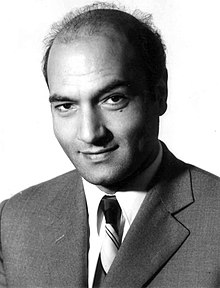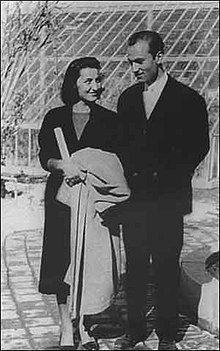Ali Shariati
Ali Shariati ( Persian على شريعتى, DMG 'Alī-ye Šarī'atī [ æˈliː ʃæriːæˈtiː ]; in English spelling Shari'ati ; * 24 November 1933 in the Iranian village Kahak at Mazinan near the town of Sabzevar in the province of Khorasan ; † June 19, 1977 in Southampton , England ) was an Iranian revolutionary and religious sociologist .
Life
Ali Schariati was the son of the religion teacher Aqa Mohammad Taqi Schari'ati and came from a family of scholars. He first studied at the Mashhad College of Education until he graduated with a BA. After Reza Shah's abdication , his father founded a center for the dissemination of Islamic truth in 1944 . Father and son took an active part in the political discussions of their time and became members of a group called the Movement of Devoted Socialists . The chief theorist of this group, Abolqassem Schakibnia, claimed that it was the prophet Mohammed who invented socialism and introduced it to the Arabian Peninsula during his time.
As a young political activist
After finishing school, Ali Shariati became a teacher in a village near Mashhad. During the time that Mohammad Mossadegh was Prime Minister, he actively supported the National Front . During this time, Ali Shariati finished translating a text entitled Abu-Tsar , a publication by Abd-al-Hamid Jowdat-al Sahar. Abu Tsar and his revolutionary version of Islam should influence Ali Shariati's further thinking.
From December 1950, Abolqassem Schakibnia published several articles by Sharia, which alluded to the Vaset concept (to Arabic al-wasatiyya, cf. in the Koran: A nation justly balanced), introduced the mathematical central value (median) used as a simile and “The median- School of Islam ” (Maktabe Vasete Islam) headlined. Attached to one of these articles was a map showing the countries of North Africa through Saudi Arabia, Turkey, Iran, Pakistan, the southern republics of the Soviet Union, and Afghanistan, and which he named the Medin Bloc . During the Cold War , the countries of the Medinic Bloc were supposed to open a “ third way ” ( Na Sharghi Na Gharbi: “Neither East, nor West” ; “Neither East nor West”), which is shaped by Islam and which is less materialistic than capitalism or communism , but rather claimed to be geared towards redemption and a fulfilled soul life. Shariati's “Neither East nor West” was later taken up by Khomeini's revolution , albeit varied : Na Sharqi Na Gharbi Jomhuri-ye Eslami: “Neither East nor West [but an] Islamic Republic”.
From November 1954, the Khorasan newspaper published a series of articles on its first page for ten weeks, entitled The Median School of Islam . This time the author was called Ali Shariati. A map similar to that in Shakibnia's publications was also reprinted as part of this series of articles, but this time the author was Ali Shariati without mentioning the previous publications by Abolqassem Shakibnia. The series of articles made Ali Schariati known in one fell swoop. The idea that Islam could show a third way, quasi an alternative social model to the crude materialism of communism and the disdainful greed of capitalism, seemed too tempting. Islam, which had always been regarded as backward and backward-looking, suddenly arrived in the modern age with the writings of Sharia.
Education
In 1955, Ali Schariati enrolled at the Ferdousī University of Mashhad, founded in 1949 . His father and the conservative clergy of Mashhad were against the opening of a university where male and female students sat in the same classroom, but Ali Shariati did not let that stop him. In addition to his work as a teacher, Schariati studied Iranian literature. After completing his studies, Schariati received a scholarship to study abroad. In May 1959, he arrived in Paris and began his studies at the Sorbonne in sociology and Islamic history, which he finished with a PhD. In Paris he took an active part in the intellectual debates on Marx and Freud , Bergson , Sartre and Camus, and on colonialism and imperialism during the “ Algerian Revolution ”. His writings, revolving around the battle of ideas, the political struggle, and a new concept of education , had a great influence on the young intellectuals of Iran and led many to the fundamentalist movement. Back in Iran, Ali Schariati tried to get a job at the University of Tehran in 1964 , but was turned down. In 1965 he was appointed Assistant Professor of History at the University of Mashhad.
At the Hoseiniye -erschād
In the mid-1960s, the circle of clergy around the Ayatollah Khomeini , such as Mahmud Taleghani , Morteza Motahhari and Mohammad Beheschti , had the idea of developing a new type of mosque, the Hoseiniye -erschād , to appeal to the Iranian middle class. In this new type of mosque one did not sit on the floor, but on chairs and the preacher stood in front of a lectern and did not sit on a raised pulpit. Ali Schariati was invited as a speaker in 1965 and soon rose to become the institution's star speaker who cast a spell over the increasing number of listeners. In his speeches, Ali Shariati raised the path of the Shiite martyr "to the only way that leads to truth and justice", and he urged his audience to "kill the tyrants or to die".
Ali Shariati developed the theory that there are two kinds of Islam, the "pure and authentic" Islam of Ali and the "corrupted Islam" of the Safavids , the ruling class that brought nothing but oppression and exploitation. With this theory, Shariati opposed the clergy, who more and more distanced themselves from Shariati and pronounced fatwas against them. He was accused of teaching Wahabism or of having apostated Shiite beliefs.
Imprisonment, emigration to England and death
Because of the rebellious speeches of Shariati, the Hoseiniye-Ershād was closed in November 1972. Shariati himself was arrested in September 1973. He was released from prison in March 1975 after having published articles in several daily newspapers criticizing Marxism and praising the reign of Mohammad Reza Shah .
After his release from prison, Ali Shariati was a broken man. Although he claimed that by publishing the pro-regime articles he was only trying to deceive the SAVAK in order to obtain his release, his reputation among the clergy and political opposition was ruined. Shariati fell into a deep depression, adopted a new surname, Mazinani, chosen after the village in which he was born, and left Iran on May 16, 1977 to start a new life in London. But it didn't come to that. Ali Mazinani Schariati died of a heart attack on June 19, 1977. The death of Shariati, which the opposition in Iran identified as the SAVAK murder, further heated the mood against Mohammad Reza Shah. Shariati was stylized as a martyr after his death and thus part of a cult that he had preached during his lifetime.
Fonts
Among his numerous Persian-language publications - as is usual with political pamphlets, in many places without an imprint - the program publication Hajj (also Hajj ) , which is distributed in numerous editions, provides a good introduction to his theory. The “Schariati Foundation” (Shariati Foundation) in Tehran published numerous studies. His work On the Sociology of Islam (edited by Hamid Algar , Berkeley, Mizan Press, 1979) is particularly dedicated to sociology . Some of his writings appeared in German in the Islamic Renaissance series published by the Press and Culture Department of the Embassy of the Islamic Republic of Iran in Bonn .
literature
- Silvia Kaweh: Ali Schariati read interculturally. Bautz, Nordhausen 2005 ISBN 3-88309-199-5
- Abbas Milani: Eminent Persians. Syracuse University , New York 2008 ISBN 978-0-8156-0907-0 pp. 359-366.
- Abdol Reza Navah: The “Islamic-Western” contrast in the image of man in contemporary Shiite contributions in Iran, with special consideration of Motahhari and Shariati. Phil. Diss. University of Kiel 1987
- Ali Rahnema: An Islamic Utopian. A Political Biography of Ali Shariʿati. London 1998 ISBN 1-86064-118-0
- Suzan Stutz: Islam and Modernity. An outline of the inner-Muslim discussion in the 20th century. KIT Scientific Publ., Karlsruhe 2013 (also Diss. Phil. KIT , Faculty of Humanities and Social Sciences 2012) ISBN 3-86644-995-X pp. 133–193. (partially readable in online bookstores. Completely readable on the KIT server as .pdf, also accessible via the DNB server )
Web links
- Literature by and about Ali Schariati in the catalog of the German National Library
- Biography of Shariati (English)
- "Hajj" by Ali Schariati
Individual evidence
- ↑ Abbas Milani: Eminent Persians. Syracuse University 2008, p. 360.
- ↑ Abbas Milani: Eminent Persians. Syracuse University 2008, p. 361.
- ↑ Persian نه شرقى نه غربى ـ جمهورى اسلامى
- ↑ a b Abbas Milani: Eminent Persians. Syracuse University 2008, p. 366.
- ↑ See Rahnema 324.
- ^ Ali Rahnema: An Islamic Utopian. IB Tauris, 2000, ISBN 978-1-86064-552-5 , p. 368. Limited preview in the Google book search
| personal data | |
|---|---|
| SURNAME | Sharia, Ali |
| ALTERNATIVE NAMES | Ali Shari'ati |
| BRIEF DESCRIPTION | Iranian sociologist and intellectual |
| DATE OF BIRTH | November 24, 1933 |
| PLACE OF BIRTH | Mashhad , ( Iran ) |
| DATE OF DEATH | June 19, 1977 |
| Place of death | England |

